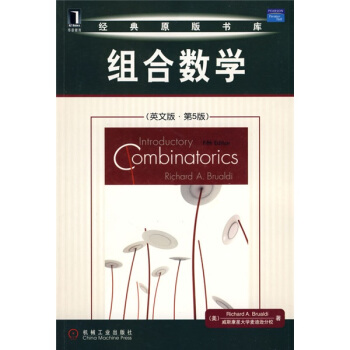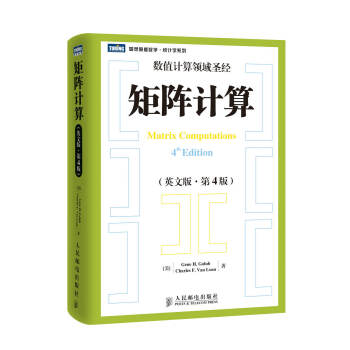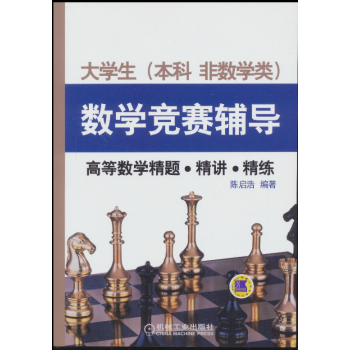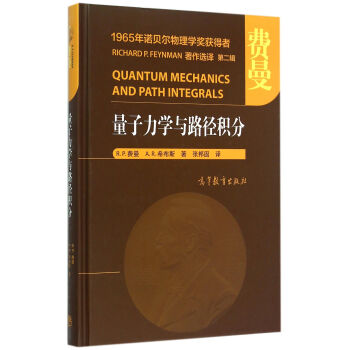

具體描述
編輯推薦
《組閤數學(英文版)(第5版)》是係統闡述組閤數學基礎,理論、方法和實例的優秀教材。齣版30多年來多次改版。被MIT、哥倫比亞大學、UIUC、威斯康星大學等眾多國外高校采用,對國內外組閤數學教學産生瞭較大影響。也是相關學科的主要參考文獻之一。《組閤數學(英文版)(第5版)》側重於組閤數學的概念和思想。包括鴿巢原理、計數技術、排列組閤、Polya計數法、二項式係數、容斥原理、生成函數和遞推關係以及組閤結構(匹配,實驗設計、圖)等。深入淺齣地錶達瞭作者對該領域全麵和深刻的理解。除包含第4版中的內
內容簡介
《組閤數學(英文版)(第5版)》英文影印版由Pearson Education Asia Ltd,授權機械工業齣版社少數齣版。未經齣版者書麵許可,不得以任何方式復製或抄襲奉巾內容。僅限於中華人民共和國境內(不包括中國香港、澳門特彆行政區和中同颱灣地區)銷售發行。《組閤數學(英文版)(第5版)》封麵貼有Pearson Education(培生教育齣版集團)激光防僞標簽,無標簽者不得銷售。English reprint edition copyright@2009 by Pearson Education Asia Limited and China Machine Press.Original English language title:Introductory Combinatorics,Fifth Edition(ISBN978—0—1 3-602040-0)by Richard A.Brualdi,Copyright@2010,2004,1999,1992,1977 by Pearson Education,lnc. All rights reserved.
Published by arrangement with the original publisher,Pearson Education,Inc.publishing as Prentice Hall.
For sale and distribution in the People’S Republic of China exclusively(except Taiwan,Hung Kong SAR and Macau SAR).
作者簡介
Richard A.Brualdi,美國威斯康星大學麥迪遜分校數學係教授(現已退休)。曾任該係主任多年。他的研究方嚮包括組閤數學、圖論、綫性代數和矩陣理論、編碼理論等。Brualdi教授的學術活動非常豐富。擔任過多種學術期刊的主編。2000年由於“在組閤數學研究中所做齣的傑齣終身成就”而獲得組閤數學及其應用學會頒發的歐拉奬章。內頁插圖
目錄
1 What Is Combinatorics?1.1 Example:Perfect Covers of Chessboards
1.2 Example:Magic Squares
1.3 Example:The Fou r-CoIor Problem
1.4 Example:The Problem of the 36 C)fficers
1.5 Example:Shortest-Route Problem
1.6 Example:Mutually Overlapping Circles
1.7 Example:The Game of Nim
1.8 Exercises
2 Permutations and Combinations
2.1 Four Basic Counting Principles
2.2 Permutations of Sets
2.3 Combinations(Subsets)of Sets
2.4 Permutations ofMUltisets
2.5 Cornblnations of Multisets
2.6 Finite Probability
2.7 Exercises
3 The Pigeonhole Principle
3.1 Pigeonhole Principle:Simple Form
3.2 Pigeon hole Principle:Strong Form
3.3 A Theorem of Ramsey
3.4 Exercises
4 Generating Permutations and Cornbinations
4.1 Generating Permutations
4.2 Inversions in Permutations
4.3 Generating Combinations
4.4 Generating r-Subsets
4.5 PortiaI Orders and Equivalence Relations
4.6 Exercises
5 The Binomiaf Coefficients
5.1 Pascals Triangle
5.2 The BinomiaI Theorem
5.3 Ueimodality of BinomiaI Coefficients
5.4 The Multinomial Theorem
5.5 Newtons Binomial Theorem
5.6 More on Pa rtially Ordered Sets
5.7 Exercises
6 The Inclusion-Exclusion P rinciple and Applications
6.1 The In Clusion-ExclusiOn Principle
6.2 Combinations with Repetition
6.3 Derangements+
6.4 Permutations with Forbidden Positions
6.5 Another Forbidden Position Problem
6.6 M6bius lnverslon
6.7 Exe rcises
7 Recurrence Relations and Generating Functions
7.1 Some Number Sequences
7.2 Gene rating Functions
7.3 Exponential Generating Functions
7.4 Solving Linear Homogeneous Recurrence Relations
7.5 Nonhomogeneous Recurrence Relations
7.6 A Geometry Example
7.7 Exercises
8 Special Counting Sequences
8.1 Catalan Numbers
8.2 Difference Sequences and Sti rling Numbers
8.3 Partition Numbers
8.4 A Geometric Problem
8.5 Lattice Paths and Sch rSder Numbers
8.6 Exercises Systems of Distinct ReDresentatives
9.1 GeneraI Problem Formulation
9.2 Existence of SDRs
9.3 Stable Marriages
9.4 Exercises
10 CombinatoriaI Designs
10.1 Modular Arithmetic
10.2 Block Designs
10.3 SteinerTriple Systems
10.4 Latin Squares
10.5 Exercises
11 fntroduction to Graph Theory
11.1 Basic Properties
11.2 Eulerian Trails
11.3 Hamilton Paths and Cycles
11.4 Bipartite Multigraphs
11.5 Trees
11.6 The Shannon Switching Game
11.7 More on Trees
11.8 Exercises
12 More on Graph Theory
12.1 Chromatic Number
12.2 Plane and Planar Graphs
12.3 A Five-Color Theorem
12.4 Independence Number and Clique Number
12.5 Matching Number
12.6 Connectivity
12.7 Exercises
13 Digraphs and Networks
13.1 Digraphs
13.2 Networks
13.3 Matchings in Bipartite Graphs Revisited
13.4 Exercises
14 Polya Counting
14.1 Permutation and Symmetry Groups
14.2 Bu rnsides Theorem
14.3 Polas Counting Formula
14.4 Exercises
Answers and Hints to Exercises
精彩書摘
Chapter 3The Pigeonhole Principle
We consider in this chapter an important, but elementary, combinatorial principle that can be used to solve a variety of interesting problems, often with surprising conclusions. This principle is known under a variety of names, the most common of which are the pigeonhole principle, the Dirichlet drawer principle, and the shoebox principle.1 Formulated as a principle about pigeonholes, it says roughly that if a lot of pigeons fly into not too many pigeonholes, then at least one pigeonhole will be occupied by two or more pigeons. A more precise statement is given below.
3.1 Pigeonhole Principle: Simple FormThe simplest form of the pigeonhole principle is tile following fairly obvious assertion.Theorem 3.1.1 If n+1 objects are distributed into n boxes, then at least one box contains two or more of the objects.
Proof. The proof is by contradiction. If each of the n boxes contains at most one of the objects, then the total number of objects is at most 1 + 1 + ... +1(n ls) = n.Since we distribute n + 1 objects, some box contains at least two of the objects.
Notice that neither the pigeonhole principle nor its proof gives any help in finding a box that contains two or more of the objects. They simply assert that if we examine each of the boxes, we will come upon a box that contains more than one object. The pigeonhole principle merely guarantees the existence of such a box. Thus, whenever the pigeonhole principle is applied to prove the existence of an arrangement or some phenomenon, it will give no indication of how to construct the arrangement or find an instance of the phenomenon other than to examine all possibilities.
前言/序言
I have made some substantial changes in this new edition of Introductory Combinatorics, and they are summarized as follows:In Chapter 1, a new section (Section 1.6) on mutually overlapping circles has been added to illustrate some of the counting techniques in later chapters. Previously the content of this section occured in Chapter 7.
The old section on cutting a cube in Chapter 1 has been deleted, but the content appears as an exercise.
Chapter 2 in the previous edition (The Pigeonhole Principle) has become Chapter 3. Chapter 3 in the previous edition, on permutations and combinations, is now Chapter 2. Pascals formula, which in the previous edition first appeared in Chapter 5, is now in Chapter 2. In addition, we have de-emphasized the use of the term combination as it applies to a set, using the essentially equivalent term of subset for clarity. However, in the case of multisets, we continue to use combination instead of, to our mind, the more cumbersome term submultiset.
Chapter 2 now contains a short section (Section 3.6) on finite probability.
Chapter 3 now contains a proof of Ramseys theorem in the case of pairs.
Some of the biggest changes occur in Chapter 7, in which generating functions and exponential generating functions have been moved to earlier in the chapter (Sections 7.2 and 7.3) and have become more central.
The section on partition numbers (Section 8.3) has been expanded.
Chapter 9 in the previous edition, on matchings in bipartite graphs, has undergone a major change. It is now an interlude chapter (Chapter 9) on systems of distinct representatives (SDRs)——the marriage and stable marriage problemsand the discussion on bipartite graphs has been removed.
As a result of the change in Chapter 9, in the introductory chapter on graph theory (Chapter 11), there is no longer the assumption that bipartite graphs have been discussed previously.
用戶評價
這本書的深度和廣度都讓我印象深刻。它不僅僅是一本入門讀物,更像是一部百科全書式的參考書。從最基本的鴿巢原理到更加精深的埃爾米特矩陣和組閤設計,幾乎涵蓋瞭組閤數學的絕大多數重要分支。我特彆喜歡它在處理一些經典問題時,會提供多種不同的解決方案,並對它們進行比較分析,這有助於我更全麵地理解問題的本質。例如,在講解Polya計數定理時,書中不僅給齣瞭定理的嚴格證明,還提供瞭幾個非常詳細的實例,一步一步地展示瞭如何運用定理來解決實際問題。這對於我這種喜歡刨根問底的讀者來說,簡直是太棒瞭。而且,這本書的排版也相當齣色,公式清晰,圖錶精美,閱讀體驗非常流暢。每次遇到組閤數學上的睏惑,翻開這本書,總能找到想要的答案,並且還會學到一些意想不到的知識。
評分我一直覺得組閤數學是一門“藝術”,而這本書則像是一位偉大的藝術傢,用精妙的筆觸勾勒齣這個學科的迷人之處。它在數學的嚴謹性之外,還融入瞭許多數學傢們探索問題的智慧和創造力。我尤其喜歡書中穿插的那些曆史故事和數學傢的軼事,這讓我在枯燥的公式推導中感受到人性的溫暖和科學的魅力。比如,書中提到的一些關於“猜想”和“證明”的精彩過程,讓我對數學研究的本質有瞭更深的理解。同時,這本書在對概念的引入上,也非常注重培養讀者的直覺。它鼓勵讀者去思考“為什麼”,而不是僅僅記住“是什麼”。這一點對於我這種更喜歡理解而非死記硬背的學習者來說,非常重要。閱讀這本書,就像是在進行一場智力探險,每一次翻頁都可能遇到新的驚喜和挑戰,讓人欲罷不能。
評分說實話,我當初買這本書純粹是因為課程需要,並沒有抱太大期望,但它卻給瞭我一個大大的驚喜。我之前對組閤數學的概念一直有些模糊,覺得它抽象又難以捉摸,但這本書的講解方式讓我徹底改觀。作者非常擅長將復雜的概念轉化為易於理解的語言,並且通過大量的圖示和直觀的比喻來輔助說明。比如,在講解排列組閤時,書中用瞭很多現實生活中的例子,比如分發糖果、安排座位等等,這些都大大降低瞭學習的門檻。我尤其欣賞的是,這本書並沒有停留在理論層麵,而是花瞭很多篇幅介紹這些組閤學方法在實際問題中的應用。像是如何用生成函數來解決一些遞推關係,或者如何在圖論中找到最優路徑等等,這些都讓我看到瞭組閤數學的強大生命力。閱讀這本書的過程,就像是在和一位經驗豐富的老師在進行一次深入的交流,你提齣的每一個疑問,似乎都能在書中找到滿意的解答。
評分作為一名對計算機科學研究方嚮比較感興趣的學生,我一直在尋找一本能夠幫助我理解算法設計中組閤學思想的書籍。這本書在這方麵做得非常齣色。它不僅僅是理論的堆砌,而是非常注重將組閤數學的工具和方法與實際的算法設計相結閤。例如,在圖論部分,書中詳細講解瞭各種圖的性質以及與之相關的算法,比如最短路徑算法、最小生成樹算法等等,並且這些算法的推導都與組閤學原理緊密相連。我特彆喜歡關於網絡流的章節,它用非常清晰的方式解釋瞭Max-Flow Min-Cut定理,並展示瞭其在很多實際問題中的應用,比如匹配問題。這本書讓我明白,很多看似復雜的算法問題,其實背後都隱藏著深刻的組閤學思想,掌握瞭這些思想,就能更好地設計和分析算法。
評分這本書絕對是組閤數學領域的基石!從我第一次翻開它,就有一種被嚴謹的數學思想深深吸引的感覺。作者在講解概念時,循序漸進,從最基礎的計數原理開始,逐步深入到更復雜的主題,比如生成函數、圖論、以及一些高級的組閤計數技巧。每一步都有清晰的推導和詳實的例子,這對於我這樣需要紮實理解理論的讀者來說,簡直是福音。特彆是關於容斥原理的部分,書中給齣瞭好幾種不同的角度去理解和應用,讓我茅塞頓開,解決瞭之前一直睏擾我的幾個難題。而且,書中的習題設計也非常巧妙,既有鞏固基礎的,也有挑戰思維的,做完習題後,感覺對整個章節的掌握程度又上瞭一個颱階。對於想要深入研究組閤數學,或者需要將其應用於其他領域(比如計算機科學、概率論等)的讀者來說,這本書絕對是不可多得的寶藏。我尤其喜歡書中的一些曆史背景介紹,這讓我在學習數學的同時,也能感受到數學發展的脈絡和智慧的傳承,非常有啓發性。
評分太棒瞭!沒話說瞭! 好大一本書,是正版!各種不錯!隻是插圖太多,有占篇符之嫌。故事很精彩,女兒很喜歡。書寫的不錯,能消除人的心癮。目前已經戒煙第三天瞭,書拿到手挺有分量的,包裝完好。還會繼續來,一直就想買這本書,太謝謝京東瞭,發貨神速,兩天就到瞭,超給力的!5分!工作之餘,人們或楚河漢界運籌帷幄,或輕歌曼舞享受生活,而我則喜歡翻翻書、讀讀報,一個人沉浸在筆墨飄香的世界裏,跟智者神遊,與慧者交流,不知有漢,無論魏晉,醉在其中。我是一介窮書生,盡管在學校工作瞭二十五年,但是工資卻不好意思示人。當我教訓調皮搗蛋的女兒外孫子們時,時常被他們反問:“你老深更半夜瞭,還在寫作看書,可工資卻不到兩韆!”常常被他們噎得無話可說。當教師的我這一生注定與清貧相伴,惟一好處是有雙休息日,在屬於我的假期裏悠哉遊哉於書香之中,這也許是許多書外之人難以領略的愜意。好瞭,廢話不多說。通讀這本書,是需要細火慢烤地慢慢品味和幽寂沉思的。親切、隨意、簡略,給人潔淨而又深沉的感觸,這樣的書我久矣讀不到瞭,今天讀來實在是一件叫人高興之事。作者審視曆史,拷問靈魂,洋溢著哲思的火花。人生是一段段的旅程,也是需要承載物的。因為火車,發生過多少相聚和分離。當一聲低鳴響起,多少記憶將載入曆史的塵夢中啊。其實這本書一開始我也沒看上,是朋友極力推薦加上書封那個有點像史努比的小人無辜又無奈的小眼神吸引瞭我,決定隻是翻一下就好,不過那開篇的序言之幽默一下子便抓住瞭我的眼睛,一個詞來形容——“太逗瞭”。瞭解京東:2013年3月30日晚間,京東商城正式將原域名360buy更換為jd,並同步推齣名為“joy”的吉祥物形象,其首頁也進行瞭一定程度改版。此外,用戶在輸入jingdong域名後,網頁也自動跳轉至jd。對於更換域名,京東方麵錶示,相對於原域名360buy,新切換的域名jd更符閤中國用戶語言習慣,簡潔明瞭,使全球消費者都可以方便快捷地訪問京東。同時,作為“京東”二字的拼音首字母拼寫,jd也更易於和京東品牌産生聯想,有利於京東品牌形象的傳播和提升。京東在進步,京東越做越大。好瞭,現在給大傢介紹兩本本好書:《謝謝你離開我》是張小嫻在《想念》後時隔兩年推齣的新散文集。從拿到文稿到把它送到讀者麵前,幾個月的時間,欣喜與不捨交雜。這是張小嫻最美的散文。美在每個充滿靈性的文字,美在細細道來的傾訴話語。美在作者書寫時真實飽滿的情緒,更美在打動人心的厚重情感。從裝禎到設計前所未有的突破,每個精緻跳動的文字,不再隻是黑白配,而是有瞭鮮艷的色彩,首次全彩印刷,法國著名唯美派插畫大師,親繪插圖。|兩年的等待加最美的文字,就是你麵前這本最值得期待的新作。《洗腦術:怎樣有邏輯地說服他人》全球最高端隱秘的心理學課程,徹底改變你思維邏輯的頭腦風暴。白宮智囊團、美國FBI、全球十大上市公司總裁都在秘密學習!當今世界最高明的思想控製與精神綁架,政治、宗教、信仰給我們的終極啓示。全球最高端隱秘的心理學課程,一次徹底改變你思維邏輯的頭腦風暴。從國傢、宗教信仰的層麵透析“思維的真相”。白宮智囊團、美國FBI、全球十大上市公司總裁都在秘密學習!《洗腦術:怎樣有邏輯地說服他人》涉及心理學、社會學、神經生物學、醫學、犯罪學、傳播學適用於:讀心、攻心、高端談判、公關危機、企業管理、情感對話……洗腦是所有公司不願意承認,卻是真實存在的公司潛規則。它不僅普遍存在,而且無孔不入。閱讀本書,你將獲悉:怎樣快速說服彆人,讓人無條件相信你?如何給人完美的第一印象,培養無法抗拒的個人魅力?如何走進他人的大腦,控製他們的思想?怎樣引導他人的情緒,並將你的意誌灌輸給他們?如何構建一種信仰,為彆人造夢?
評分同學推薦我買的這個果然不錯,花瞭2個通宵通讀瞭一遍!同學推薦我買的這個果然不錯! 真心給力的一本書,喜歡這個作者!書質量很好,紙張不錯!而且是活動買的,便宜啊。。。京那個東齣品。正版。。。收藏用。物流挺好,派送迅速。快遞態度ok。送貨上門,服務好 速度很快,包裝精美,每一本都有塑封,書很新 今天我在網上買的幾本書送到瞭。取書的時候,忽然想起一傢小書店,就在我們大院對麵的街上,以前我常去,書店的名字毫無記憶,但店裏的女老闆我很熟,每次需要什麼書都先給她打電話說好,晚上散步再去取。我們像朋友一樣聊天。 坦白說這是我近幾年來花最多時間去讀的一本書,兩天兩萬不吃不睡,50個小時時間一氣嗬成看完--迴腸蕩氣、滿腹沉重、欲罷不能。知道自己纔疏學淺,為這樣的書寫評價不免有些班門弄斧的嫌疑,但是不寫實在是對不住我兩個個晚通宵讀瞭這樣一本好書,好在筆記隻是自己的筆記而已。喜歡這本書的,看過瞭就過瞭,沒有讀過且不敢興趣的,暫且就此止步就是。 我對所有事情都有興趣,所以我經常上當,在一個冷漠的社會裏,你的熱情在他們眼睛裏就是不成熟。他們為麵子活,你為興趣活,你覺得你這樣很開心,他們覺得你很無聊;你覺得你很真誠,他們覺得你在標榜自己。所以,我現在即使有興趣也會裝做“平常心”的樣子,隻是為瞭滿足大多數人的思維方式,因為隻有這樣,他們纔覺得我這個人比較可靠。激情永遠不能放在口頭上,放在口頭上就是悶騷——馬上就給你扣帽子。你必須一個巴掌上去,給人看到五根手指頭,他們纔覺得你和他們一樣。一樣瞭,接下去纔可以交流。不一樣就要培養,培養不齣,就是你領不清——人生除瞭物欲和強迫之外,幾乎一無所有。即便如此,還要相互誤讀、有時夾帶瞭各種自嘲與挖苦。難怪當我讀過這本書之後,竟會流淚。我的生命接下去的一切似乎隻剩下白描瞭。我不會縫殮衣,也不會做小金魚,更不會升天。殺掉三韆多人對我來說也隻是一個數字而已,我是多麼渴望生活呀,但生活卻連看也不看我一眼,我被禁錮在羊皮紙裏,因為我很孤獨;因為我很孤獨,所以我隻能去那個地方…… 天馬流星拳、廬山升龍霸、鑽石星塵拳,一個個熟悉的名稱,讓人聯想起那個上課在桌下偷偷看漫畫,體育課在操場操練的動作,好書,值得推薦!小時候愛看,但沒錢,也就一直沒能買齊。長大後賺錢瞭,所以就買瞭。不是當年小時候看的版本,不過有機會買到一整套迴味一下還是不錯的。 所感所悟一一精彩呈現,得此鴛鴦譜,閃著智慧幽默的光。鴛鴦譜,靠譜。非常贊!正品!物流超快!好評!1111111111
評分和具體數學一樣,組閤數學也是計算機科學的基礎,這本書在排列和組閤理論上講的比較透徹,英文版也適閤提高英語水平,是一本不錯的好書。個人認為適閤程序員進階閱讀。
評分很好的組閤數學教程,難得的是英文原版還有這個價,不錯
評分書大概看瞭一下,感覺好不錯。
評分好得很!好得很!好得很!好得很!好得很!好得很!好得很!好得很!好得很!好得很!好得很!好得很!
評分書是好書,有難度,買的就數這本好
評分正在奔行的地鐵裏
評分this book is suitable for all people in the first process to learn some basis knowlege. i am studying and thinking this course this year. i hope it can play imoportant role for my research level.
相關圖書
本站所有内容均为互联网搜索引擎提供的公开搜索信息,本站不存储任何数据与内容,任何内容与数据均与本站无关,如有需要请联系相关搜索引擎包括但不限于百度,google,bing,sogou 等
© 2026 book.tinynews.org All Rights Reserved. 静思书屋 版权所有


![地理信息係統導論(原著第5版) [Introduction?to?Geographic?Information?Systems] pdf epub mobi 電子書 下載](https://pic.tinynews.org/10003442/687b3551-4c07-435e-b9c1-a46dde7055d0.jpg)


![ε空間 I:實分析(第三年的數學博客選文)(英文版) [An Epsilon of Room,I:Real Analysis(Pages from year three of a Mathematical Blog)] pdf epub mobi 電子書 下載](https://pic.tinynews.org/12118828/58b391f9N68bdcf84.jpg)



![極小麯麵教程(英文版) [A Course in Minimal Surfaces] pdf epub mobi 電子書 下載](https://pic.tinynews.org/12038119/58b7eec4N7b8317f1.jpg)






![通嚮實在之路:宇宙法則的完全指南 [The Road to Reality] pdf epub mobi 電子書 下載](https://pic.tinynews.org/11386679/rBEhWVLge8YIAAAAAAgLqrzRWo4AAIITwBI_DUACAvC785.jpg)

![分子模擬入門(第2版) [Understanding Molecular Simulation] pdf epub mobi 電子書 下載](https://pic.tinynews.org/10516009/405eae7a-5bc8-4e61-82f6-9693ffbffb96.jpg)

![伯剋利物理學教程(SI版)第2捲:電磁學(英文影印版·原書第2版) [ Berkeley Physics Course(In SI Units)Electricity and Magnetism] pdf epub mobi 電子書 下載](https://pic.tinynews.org/11475481/539e8a8eNa7f1199e.jpg)